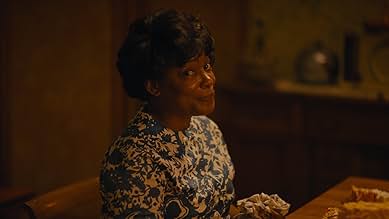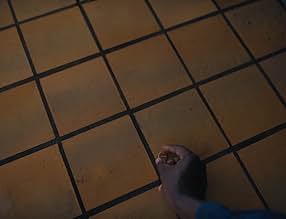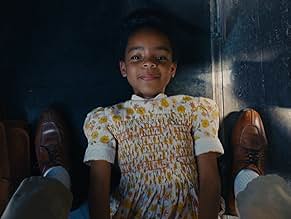Ajouter une intrigue dans votre langueA powerful friendship develops between two young Black men as they navigate the harrowing trials of reform school together.A powerful friendship develops between two young Black men as they navigate the harrowing trials of reform school together.A powerful friendship develops between two young Black men as they navigate the harrowing trials of reform school together.
- Réalisation
- Scénario
- Casting principal
- Nommé pour 2 Oscars
- 60 victoires et 179 nominations au total
- White Boy
- (as Zachary Luke Van Zandt)
Résumé
Avis à la une
"Nickel Boys" is bi-perspectival. We experience the gazes of two different characters, Elwood and Turner, teenagers incarcerated in a Jim Crowe-era juvenile detention center that amounts to a borderline death-camp for its Black prisoners. I was struck by the similarities and differences between "Nickel Boys" and "Hunger", another overpowering work on life-in-detention. The older film is about the body to a visceral degree that few other movies have attempted and the result is a work of relentless objectivity. "Nickel Boys", by contrast, is about the effects of trauma and imprisonment on the mind and memory- a relentlessly subjective piece.
The tone is thus very different from that of most bleak prison dramas, at times almost affirmational. We're experiencing, literally seeing, the way Elwood and Turner view their conditions in ways that make their situation tolerable- largely by focusing on their friendship- each other's faces- and those of their loved ones. This is not to say that the film is artificially pleasant. One of the best scenes consists of a single long take of a conversation in a bar years after the events depicted in most of the film have taken place. It's a remarkably well staged and performed scene featuring brief but memorable work by actor Sam Malone as Percy, one of the detention center's survivors, uttering the horrors he witnessed in a tone that suggests that even years later he can barely cope with what he saw. Experiences like those inflicted on the characters perhaps cause more damage after the fact than during the actual experience when survival instinct takes over.
The bi-perspectival construction of the film also demonstrates the ways that experiences and memories are never fully constructed or belonging to any one individual. Elwood and Turner, for all of their differences, come to seem almost like one character. We start to forget, or care, about whose perspective we are viewing. These men are forging this part of their lives together- they are co-authors of each other's experience. In this sense, "Nickel Boys" is about themes larger than imprisonment and injustice. It's about the ways that time and memory enact experience, both making it palatable but in the process leaving defining scars. The film's final montage features images of cellular reality- our being recreating itself through creation and destruction even within a single lifetime.
"Nickel Boys" is not a perfect movie. Ross's previous work had been as a documentarian and the script he co-wrote with Joslyn Barnes and Colson Whitehead is characterized by some clunky, overly on-the-nose dialog. However, this makes the powerful performance of said dialog by stars Ethan Herisse, Brandon Wilson, and especially Aunjanue Ellis-Taylor as Elwood's grandmother, all the more impressive.
RaMell Ross's Nickel Boys is not a film that watches passively. It demands engagement, understanding, and empathy from its audience, much like the Pulitzer Prize-winning novel by Colson Whitehead on which it is based. Through its daring visuals and emotionally charged storytelling, Nickel Boys immerses viewers in the horrors of the fictional Nickel Academy, a reform school in 1960s Florida modeled after the real-life Dozier School for Boys.
The film follows Elwood (Ethan Herisse) and Turner (Brandon Wilson), two young Black men navigating the systemic abuse, violence, and dehumanization at Nickel Academy. Ross opts for an intimate, first-person cinematic technique with the help of director of photography Jomo Fray, ensuring the audience doesn't just watch the story but experiences it through the eyes of its protagonists. From the stolen car that seals Elwood's fate to the mirrored ceiling reflecting fleeting moments of connection, the cinematography is both haunting and poetic.
Ross doesn't shy away from discomfort. Instead, he leans into it, capturing moments of injustice with brutal authenticity. One of the film's most harrowing sequences involves a Nickel supervisor (Hamish Linklater) doling out punishment. The violence occurs off-screen, but the chilling sound of the strap and the visceral reactions of the boys leave an indelible mark. The film also uses historical references, like cutting in scenes from 1958's The Defiant Ones, to deepen the emotional resonance of Elwood and Turner's attempted prison break.
The performances are as captivating as the story. Herisse brings a quiet determination to Elwood, while Wilson's Turner is a revelation, showcasing a raw vulnerability that makes his arc unforgettable. Aunjanue Ellis-Taylor delivers a heartbreaking turn as Elwood's grandmother, Hattie, and Fred Hechinger exudes sinister menace as a trustee of the academy. In flash-forwards, Daveed Diggs portrays one of the survivors grappling with the haunting legacy of Nickel, a reminder that systemic racism's scars endure far beyond the immediate trauma.
POPULAR ON THE CINEMA GROUP
Ross masterfully balances artistry and substance, using his background as a photographer and documentarian (Hale County This Morning, This Evening) to craft a narrative that feels both tactile and transcendent. The visuals are stunning-orange trees swaying in the breeze, civil rights protests flickering on storefront TVs-but they never overshadow the film's thematic weight. The film dares to ask: How do you bear witness to atrocities while maintaining hope for a better future?
Ross's unique approach to storytelling is complemented by an equally daring narrative structure. The film's immersive technique places the audience directly into the emotional and physical landscapes of its characters. By shifting perspectives between Elwood and Turner, the audience is given a multi-faceted view of life at Nickel Academy-its suffocating oppression and fleeting moments of resilience. These shifting perspectives create a layered narrative that resonates on both personal and societal levels.
Some may find Ross's immersive, collage-like approach challenging, but it's precisely this audacity that makes Nickel Boys a must-watch. It's not just a film about the past but a searing indictment of a present still shaped by institutional racism in new and disturbing forms. The juxtaposition of Elwood's unyielding hope with Turner's hardened pragmatism paints a poignant picture of the different ways individuals navigate systemic oppression. This duality adds emotional depth to the story, making it both heart-wrenching and thought-provoking.
Ross also introduces moments of unexpected beauty amidst the darkness. The tactile warmth of a breeze on an orange tree, the quiet solidarity of shared meals, and the fleeting joy of stolen moments all serve as reminders of the humanity that persists even in the face of unimaginable cruelty. These moments are not mere embellishments but integral parts of the narrative, highlighting the resilience of the human spirit.
The film's climax, centered around Elwood and Turner's daring escape, is a masterclass in tension and emotional weight. The use of intercut scenes from The Defiant Ones adds a layer of meta-commentary on the history of cinematic depictions of race and resistance. The pursuit by a white trustee, portrayed with chilling menace by Fred Hechinger, serves as a stark reminder of the pervasive and relentless nature of systemic racism.
Nickel Boys is more than a movie-it's a cry for justice, a call to action, and a work of art that demands to be felt as much as seen. RaMell Ross's fearless storytelling, coupled with extraordinary performances, ensures this adaptation is both unforgettable and necessary. It challenges us to confront our shared history while offering glimmers of hope that change, however incremental, is possible.
Reviewed At Opening Night of the 62nd New York Film Festival at Alice Tully Hall on September 27, 2024.
I'm now going to list all those 'fresh' approaches of the director. However, I cannot find the 'purpose' of these approaches. Why does he choose these specific tools and forms to create what effect on the audience? None of them are answered. First, screen ratio. The director chooses a 1.33:1 ratio. It rather feels stuffed, blocking a wider view. My sight is blocked the whole time. Second, lots of montage, jagged editing, and lots of quick cuts. Again, I don't know why the director chooses this way, and I'm sure his intention has failed because It feels chopped and segmented, hindering the continuity and the flow of the movie and making the ending more confusing. In addition to these editing problems, story development is slow, making things worse.
The film follows Elwood Curtis, a bright and idealistic young black man wrongly sentenced to the Nickel Academy, a supposed institution of learning that is, in reality, a breeding ground for sadism and racial violence. We witness the horrors through Elwood's eyes, alongside his more cynical companion, Turner. However, witnessing these horrors is a frustratingly difficult task, thanks to Ross's baffling stylistic choices.
Instead of establishing a sense of place and allowing the audience to breathe in the suffocating atmosphere of Nickel, the film throws us into a relentless barrage of close-ups. Faces fill the frame, disembodied and divorced from their surroundings, leaving us with no context for their expressions or the environment that informs them. This constant proximity might have been effective in creating intimacy if it wasn't paired with a dizzying array of first-person perspectives.
We're thrust into the shoes of various characters, often with no clear indication of who we're supposed to be inhabiting. The camera becomes an erratic, disorienting stand-in for the eyes of the boys, sometimes even inexplicably positioned to stare at the back of Elwood's head. This technique, presumably intended to immerse us in the characters' subjective experiences, achieves the opposite effect. It detaches us, leaving us scrambling to understand basic spatial relationships and the narrative flow.
The result is a chaotic, disorienting mess. Scenes that should be emotionally impactful are reduced to a jumble of fragmented images. Key moments of violence are obscured by the shaky, often illegible camerawork. The film's attempts at conveying the psychological toll of trauma are lost in the visual clutter. It's as if the filmmakers were so determined to avoid a conventional approach that they forgot the fundamental purpose of cinematography: to tell a story visually.
While the performances from the young cast are commendable, particularly Ethan Herisse as Elwood, their efforts are ultimately undermined by the film's impenetrable style. "The Nickel Boys" had the potential to be a powerful and necessary piece of cinema, but it is ultimately undone by its own cinematic excesses. Instead of illuminating Whitehead's devastating story, the film buries it under a mountain of ill-conceived visual choices, leaving the audience lost in the dark, struggling to see the tragedy unfolding before them. It's a film that tragically fails to understand that sometimes, less truly is more.
5 Film Recs From Director RaMell Ross
5 Film Recs From Director RaMell Ross
Le saviez-vous
- AnecdotesIn an interview with Vanity Fair, director RaMell Ross states ""The film is conceived as all one-ers. In one scene, we shot everything from Elwood's perspective, and then everything from Turner's--one from the first hour, and then the other for the second. Very rarely did we shoot both perspectives on a scene, though, because of the way it was written and scripted. We don't always go back and forth. So it's shot like a traditional film, except the other character is not there. They're just asked to look at a specific point in the camera. Typically, the other actor is behind the camera, reading the lines and being the support to make the other person feel like they're actually engaged with something relatively real. Because they're all one-ers, though, the choreography is quite difficult."
- GaffesEarly in the movie, when MLK is shown on various TV screens in the window of a store, you can see the camera's reflection in the bottom left of the screen.
- Citations
Turner: This can be a three-day job we play it right. We till the garden and fix up her house, she may even adopt our black asses. Well not you, you got family. I'd yessum her for a chance out of Nickel.
Elwood: That ain't no freedom. I mean you know Director Hardee and his wife ain't supposed to use us like we're slaves.
Turner: Man, all those guys on the school board have us do chores. Sometimes it's favors, sometimes it's for real money.
Elwood: But it's against the law.
Turner: [Turner laughs] Man, the law's one thing. You can march and wave signs around and change a law if you convince enough white people. I saw those college kids in Tampa with their nice shirts and ties sitting at the Woolworth's. I had to work, but they were out protesting. And it happened, they opened that counter. But I didn't have the money to eat there either way. Gotta change the economics of all this, too.
Elwood: My grandma got me that lawyer, man. Make a move there, first.
Turner: The courts play both the white and the black. They just move us around when they're ready.
Elwood: And we have to be like knights. Checkmate.
Turner: How many people you know done that, El? There's four ways out of Nickel. Serve your time -or age out-. Court might intervene -if you believe in miracles-. You could die -they could kill you-. You could run. Only four ways out of Nickel.
- ConnexionsFeatured in WatchMojo: Top 10 Best Movies of 2024 (2024)
- Bandes originalesYoung Girl
Written, Composed, and Produced by Herschel Dwellingham
Performed by Frank Lynch
Courtesy of Grass of Home Productions and Publishing (BMI)
Meilleurs choix
- How long is Nickel Boys?Alimenté par Alexa
Détails
Box-office
- Budget
- 20 000 000 $US (estimé)
- Montant brut aux États-Unis et au Canada
- 2 858 346 $US
- Week-end de sortie aux États-Unis et au Canada
- 54 794 $US
- 15 déc. 2024
- Montant brut mondial
- 3 016 380 $US
- Durée2 heures 20 minutes
- Couleur
- Rapport de forme
- 1.33 : 1





































